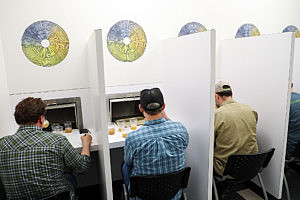Some people think working at a brewery means we just sit around and taste beer all day. Well, perhaps it’s not all day, but it is pretty much every day. Here at Tröegs, we employ a vigorous sensory panel training, and only co-workers with the most discerning palates make the grade. If you’ve ever been curious about this aspect of quality control at Tröegs, here is your chance to brush up on how our tasting panel works.
First, here’s a little history lesson on how it all started.
We formalized our Tasting Panel in 2011 when we moved our brewery to Hershey from its original location in Harrisburg, PA. However, we had informal programs for years before that.
The program started with diacetyl tests of Sunshine Pilsner, a classic balance of two-row barley, zesty Saaz hops and lager yeast. Back then, we would pull trusted co-workers to taste every single fermenter of Sunshine to make sure the diacetyl had been reabsorbed by the yeast.
“It grew through need and necessity,” says brewmaster and founding brother John Trogner. “The first taste panel was us randomly tasting from the tanks and deciding if the beer could go to the next step in production. And from there, it kept getting more and more formal and we started keeping records.”
In 2011, when our new Hershey brewery gave us the space for a fully developed lab and sensory room, we upped our game and formalized the program. Our Quality Manager Ben Bailey started to train and test co-workers with spiked beer samples.
“We use about a dozen of the most common off flavors like diacetyl, metallic and oxidation,” says Bailey. “And we also use spikes that give us insight into a taster’s ability. Are they able to differentiate esters, sulphur compounds and phenolics? That gives us a way to judge general ability on panel. We also have a gas chromatograph that detects diacetyl, but we still taste the beer at the end of fermentation.”
So, who is involved with our tasting panel at the brewery?
Any full-time co-worker is eligible to join our Taste Panel. “Position in the company means nothing,” says Bailey. Our tasting panel convenes at least once a day seven days a week, and we now have 12 trained tasters who have passed our rigorous test. Trust us … it isn’t easy!
“I see the taste panel as a direct link to our customer experience,” says Trogner. “Each step of the brewing process, from ingredient selection to packaging, could be catastrophic for the flavor of the beer, or small problems could add up and cumulatively cause a bad experience for our fans. So we evaluated the most critical points along the way and trained people to guard that Tröegs experience. Our taste panel ensures that when someone grabs a Perpetual IPA, they get a Perpetual IPA.”
“Having people with the proven ability to identify individual compounds and off flavors in a beer is so much more valuable than someone simply saying, ‘This beer is bad,’” says Bailey. “Trained tasters help us narrow down where problems may arise so we can zero in on a problem and get it fixed.”
So, what’s coming down the road for our tasting panel?
“There are two aspects we want to expand,” says Trogner. “The first is that defensive side, making sure our customers are having a great experience, so we want to hire a person dedicated to training more tasters. The other component is our ability to more quickly move a beer from early experimental batches to a packaged beer on the shelf.”
In late 2019, we installed our new nano Scratch Lab. The 3-hectoliter brewhouse and eight fermenters allow us to trial nuances to recipes and taste them side-by-side.
“Now we can take one Scratch knockout and split it into five or six tanks for yeast, hop and fruit experiments,” says Trogner. “In the past, a few brewers could take a growler or two home and compare batches, but you can’t do that with 10 or 12 different variations. So we want someone who can help us get a more statistical view so we can get better at evaluating those test batches.”
Share:Original Source Here

